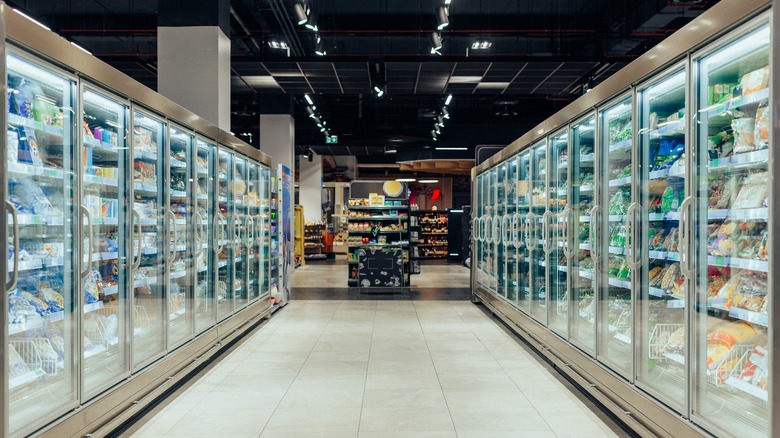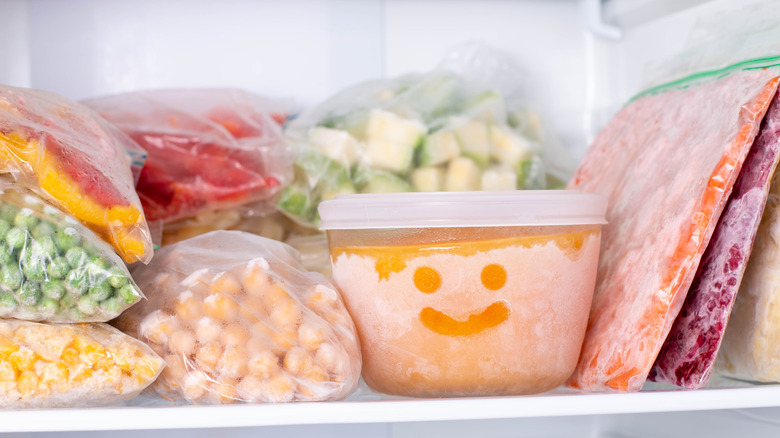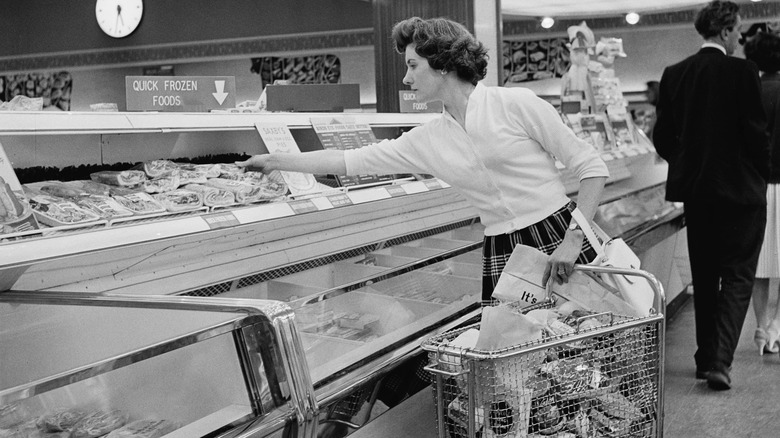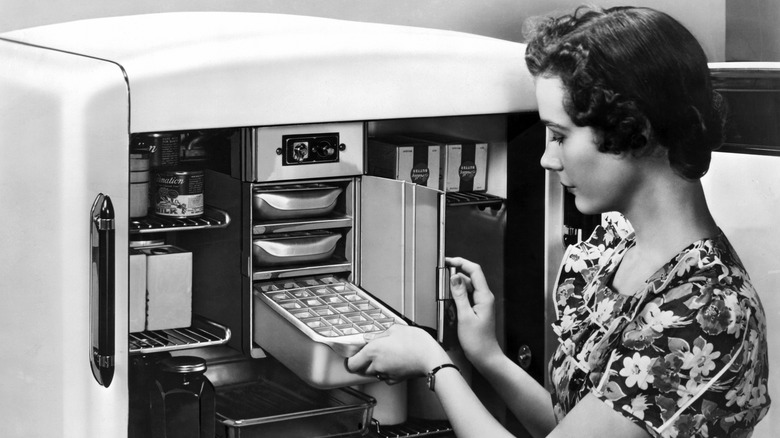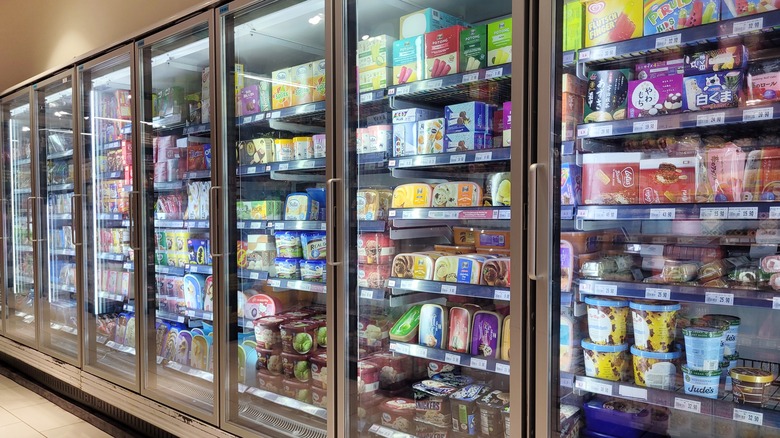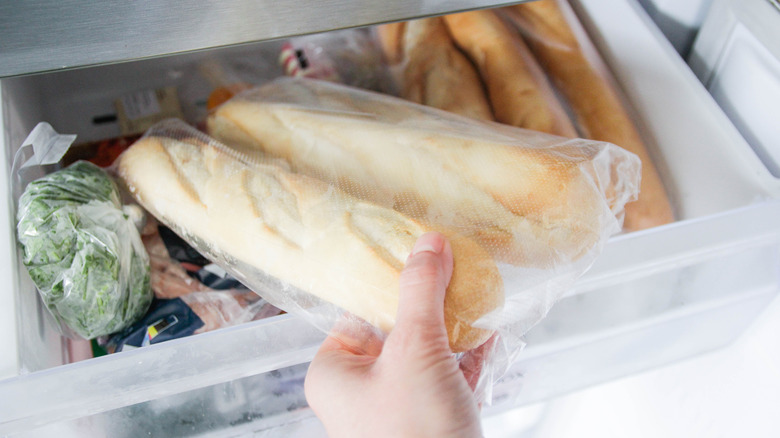The Origins Of The Freezer Aisle Go Back Way Farther Than We Thought
Whether stocking up on grab-and-go breakfasts or looking for an easy dinner that you rely on staying fresh and ready a few weeks from now, frozen food is a reliable option you shouldn't ignore while shopping. The frozen food aisles in a grocery store offer icy versions of produce, meat, and pre-cooked meals that have saved our dinner plans on several occasions. Per GroceryDive, a study by The Food Industry Association and the American Frozen Food Institute found that frozen food sales steadily rose in the United States in 2023, with 38% of shoppers prioritizing buying and consuming frozen food items daily. Most modern-day consumers see frozen foods as a good investment, storing their freezers with ingredients and meals that can be kept for a long time without spoiling.
Having frozen foods on hand also allows busy consumers to plan meals ahead of time with little prep. But shoppers could not always purchase items that would sit in their freezer for weeks at a time. In fact, it wasn't until 1930 that foods began to arrive frozen at grocery stores with the intention of selling to customers while still icy. The concept of frozen food dates back to ancient civilizations, long before extra tall freezers held all your goodies behind glass doors at the store — although you likely couldn't find air fryer-ready pizza rolls back then.
Freezing food has been a preservation method since 1000 B.C.
Prior to the invention of flash-freezing and manufactured frozen foods, the practice of freezing food was passed down as a means of preservation originally discovered by ancient civilizations in China. Evidence of freezing foods has been found as early as 1000 B.C. when raw meat would be stored in ice cellars to elongate its shelf life. People in the Inca civilization also found a way to preserve potatoes by freezing them in the cold, squashing them to wring out moisture, and then drying the root vegetable in the sun to achieve a dehydrated potato that lasted much longer without spoiling.
Food begins to expire when it is exposed to elements like moisture and heat over a long period. In these conditions, bacteria start to grow within the food, affecting the taste, smell, and texture, and can even make people sick after ingesting if too much bacteria has grown (via USDA). Chilling fresh food to freezing temperatures works to preserve food because the severe cold prevents this bacteria from growing. While we as a society have understood this process for a very long time, it wasn't until the 20th century that manufacturers found a way to quickly freeze, package, and transport foods that could be kept just as cold at home.
The invention of fast freezing introduced a whole new section to grocery stores
Canadian engineer Clarence Birdseye is credited as the genius behind modern-day frozen foods. Before Birdseye's innovations, attempts at freezing food to preserve it led to soggy textures due to poor packaging or extremely dry foods if the contents took too long to reach freezing.
Birdseye took inspiration from the ice fishing traditions of Inuit people in Canada, who would place freshly caught fish on the icy ground to prevent it from becoming soggy and mushy once thawed. He found that the key to frozen food that still tasted good was freezing it right away, ushering in the invention of flash-freezing. By 1930, his business, Birds Eye Frosted Food Company, introduced the first line of frozen foods to grocery stores. According to NPR, the company's newest machinery could flash-freeze and package 18 different types of meat and fish, as well as various fruits and vegetables, including frozen peas that were advertised "as gloriously green as any you will see next summer."
Freezers are a relatively new addition to common household appliances
While Clarence Birdseye's line of frozen foods was revolutionary, it took a while for households to catch up to this innovative new kind of food. Large freezers were introduced into grocery stores in 1930 to accommodate, but it wasn't until the 1940s that people began investing in domestic freezers that could keep food frozen in their homes. The need for an at-home freezer was especially critical during World War II when most canned goods were shipped overseas to feed the troops, and people at home needed to figure out a way to preserve fresh produce and meats.
As the workforce changed and money became tight, the famous frozen TV dinner arrived on the scene, providing people with a fast, cheap way to feed their families. The introduction of a meal containing protein, starch, and vegetables all heated up as one was already a bargain, but the added benefit of freezing them for months without fear of spoiling was the aspect of the frozen dinner that drove it to new heights. By 1955, TV dinners were massively popular, becoming a staple meal in American households that can still be found in freezer aisles at grocery stores today. Thankfully, the variety of flavors and cuisines offered nowadays has expanded.
Today, the freezer aisle offers a wide selection of cuisines
In modern grocery stores, the ever-popular frozen dinner is just one of many frozen food items that may catch your eye while browsing. From frozen pizzas to breakfast burritos and entire servings of Kung Pao Chicken just waiting to be thawed and reheated, the options have evolved and expanded over the years. However, some may believe this expansion hasn't been for the better. Certain shoppers believe the myth that frozen food is salty and unhealthy, offering shoppers little when it comes to flavor, variety, or nutrition. Fortunately, this sentiment isn't wholly accurate. While ready-made snacks and dinners are available in stores that can be considered junk food, there are freezer aisles stocked with frozen vegetables, fruits, and nutritious proteins. The freezer aisle is also a great place to look for people with dietary restrictions who still want to indulge in their favorite snacks. A quick glance and you'll likely find vegan sausages, gluten-free pizza crusts, and an assortment of dairy-free ice cream flavors scattered about the freezer section. In reality, frozen food is not a genre of food meant to be labeled "healthy" or "unhealthy," it is a means of preserving and storing all types of food for later consumption — it is up to the shopper to decide what meals and ingredients best suit their dietary needs.
Do items in the frozen foods section actually expire?
Buying food from the freezer section is a great way to elongate the shelf life of perishables that would otherwise spoil within a few days of purchasing. But does there come a time when our frozen foods are no longer safe to eat? We've all fallen victim to losing food to the back of our freezer, only to discover it months later and make the tough decision to toss it rather than gamble whether or not it is expired. According to the USDA, frozen foods can be kept "almost indefinitely" and still be safe to eat once they are thawed and prepared. However, this does not guarantee that your food will taste just as good after being frozen for years.
If you spot expiration dates on your frozen foods, it is more often referred to the last date that the food will offer peak freshness. Most frozen items, both pre-frozen from grocery stores and fresh ingredients stored in the freezer, maintain peak freshness for three to four months before taste and quality decline. After that, most food safety specialists recommend checking your food's look and smell before eating two-year-old frozen meat or a TV dinner with signs of freezer burn.
